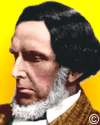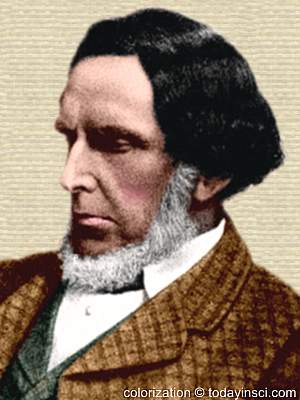 (source)
(source)
|
Robert Mushet
(8 Apr 1811 - 29 Jan 1891)
English metallurgist who developed a method of manufacturing steel (1856) by the addition of manganese, which improved on the Bessemer process.
|
Robert Mushet's Steel Process
from Steel: Its History, Manufacture, Properties, and Uses
by James Stephen Jeans (1880)

[p.120] The process of manufacturing steel patented, and for some time carried on, by Robert Mushet consisted in employing as a flux in place of peroxide of manganese, chromate of iron, oxide of chrome, or an artificial mixture of chrome oxide and oxide of iron. But as natural chromate of iron answers perfectly for this process, and is far cheaper than chrome oxide or artificial mixtures of chrome oxide and oxide of iron, the inventor preferred to use the natural chromate of iron. Chromate of iron is a mineral found abundantly in nature, and consisting essentially of the oxides of chrome and iron. The chromate of iron employed by Mushet was that which is most free from gangue or veinstone, and likewise free from sulphur and phosphorus, which latter are sometimes found associated with chromate of iron. The chromate of iron was prepared for this process by pulverizing or by breaking into small pieces; or it was used in the granulated state, in which it is frequently found in nature.
Mushet successfully carried on for some years at Coleford the manufacture of steel by a modus operandi which is described as follows:—Bar-iron is cut up into pieces of about one ounce weight. These are melted in steel-melting pots, with a small proportion of two other metals, from which the gun-metal derives its peculiar properties. The hardness of the alloy is regulated by adding a certain proportion of charcoal. After fusion the alloy is poured into moulds, and a bloom or ingot of gun-metal is obtained. The softer varieties can be welded like cast steel, but not the harder varieties, and its tenacity in all cases is impaired by raising it to a welding temperature. It ought therefore to be rolled or drawn out at a cast-steel heat.*
A considerable degree of success was also achieved by Mushet in the manufacture of so-called Titanic steel for tools. It is stated that [p.121] this steel, after being heated red hot and suffered to cool slowly, still remains harder than any ordinary cast steel tempered at straw colour. It is hard and brittle, and seldom reaches a tensile strain of 40 tons per square inch.
- 8 Apr - short biography, births, deaths and events on date of Mushet's birth.
- Robert Mushet Biography - from Dictionary of National Biography (1909)




